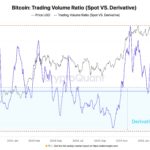
US GDP Declines by 0.3% in Q1 2025, Raising Concerns of Stagflation as Bitcoin Remains Steady Amid News
According to the Commerce Department’s early estimate, the US GDP declined at an annual rate of 0.3% during the first quarter.
Real final sales to private domestic buyers, which gauge the underlying demand, grew by 3.0%, following a prior increase of 2.9%. Additionally, the price index for gross domestic purchases rose to 3.4%. The personal consumption expenditures index increased by 3.6%, with the core measure, excluding food and energy, rising by 3.5%.
Bea mentioned,
“The decline in real GDP during the first quarter was largely due to a rise in imports, which negatively impacts the GDP calculation, and a reduction in government spending. These shifts were partially balanced by growth in investment, consumer expenditures, and exports.”
This indicates that a cutback in government spending combined with a surge in imports, stemming from tariff concerns, has resulted in a numerical decrease in GDP. However, this situation transcends mere political narratives; the surrounding perceptions are unfavorable, and further declines might occur in Q2 as the tariff effects become clearer, suggesting a probable recession.
This latest figure follows a 2.4% increase in GDP for the last quarter of 2024, with an average projection of 0.4 percent. The Bureau of Economic Analysis will revise this estimate on May 29 and June 26.
Forecasts from Trading Economics showed an anticipated growth of 0.5%, while the general expectation was pegged at 0.3%.
Following this announcement, Trading Economics revised its Q2 prediction to a decline of 1.2%, suggesting that a technical recession is becoming increasingly likely. The probability of a recession on Polymarket surged to 71%.
Prior to the figures’ release, Bitcoin, oil, and stocks experienced slight declines, while gold saw a small increase.
Upon the announcement, Bitcoin dropped 0.5%, S&P 500 futures fell by 0.77%, and US 10-year Treasury yields climbed by 0.35%.
Real-time indicators showed divergence ahead of the release: the Atlanta Fed’s GDPNow model indicated a -2.7% as of April 29, while the New York Fed’s Staff Nowcast suggested a growth of 2.6 percent. Consensus expectations shifted frequently as weak manufacturing data clashed with more robust housing and service indicators.



















Post Comment